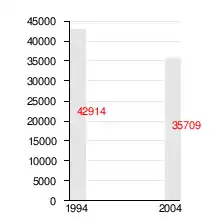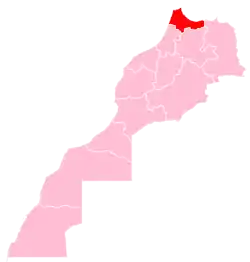Chefchaouen
Chefchaouen (Arabic: شفشاون Shafshāwan [ʃəfˈʃɑːwən]; Berber languages: ⴰⵛⵛⴰⵡⵏ Ashawen), also known as Chaouen, is a city in northwest Morocco. It is the chief town of the province of the same name, and is noted for its buildings in shades of blue. Chefchaouen is situated just inland from Tangier and Tétouan.
Chefchaouen
شفشاون ⴰⵛⵛⴰⵡⵏ | |
|---|---|
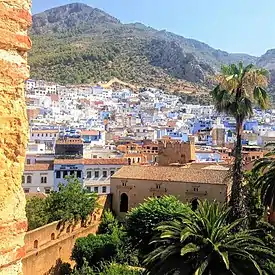 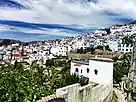 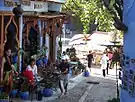 .jpg.webp)  _-_Chaouen.jpg.webp) | |
| Nicknames: The Blue Pearl الجوهرة الزرقاء | |
 Chefchaouen Location of Chefchaouen in Morocco 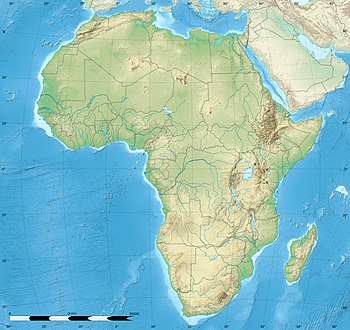 Chefchaouen Chefchaouen (Africa) | |
| Coordinates: 35°10′17″N 5°16′11″W | |
| Country | |
| Province | Chefchaouen |
| Founded | 1471 |
| Government | |
| • Governor | Mhamed Haddan |
| • Mayor | Mohamed Said al-Alami |
| Elevation | 564 m (1,850 ft) |
| Population (2014) | |
| • Total | 42,786 |
| Time zone | UTC+1 (CET) |
History
The city was founded in 1471[1] as a small kasbah (fortress) by Moulay Ali ibn Rashid al-Alami, a descendant of Abd as-Salam al-Alami and Idris I, and through them, of the Islamic prophet Muhammad. Al-Alami founded the city to fight the Portuguese invasions of northern Morocco.[2] Along with the Ghomara tribes of the region, many Moriscos and Jews settled here after the Spanish Reconquista in medieval times.[3] After eight years of the creation of the Spanish Protectorate in Morocco the Spanish Army could effectively take Chaouen, when General Dámaso Berenguer occupied the city on 14 October 1920.[4]
Following the 1924 retreat of the Spanish army from the city,[4] Chaouen was part of the Republic of the Rif (led by Abd el-Krim el-Khattabi) from 1924 to 1926.[5]
In September 1925, in the middle of the Rif War, a rogue squadron of American volunteer pilots, including veterans of World War I, bombarded civilians in Chaouen.[6] Colonel Charles Michael Sweeney had proposed the idea to French Prime Minister Paul Painlevé, who "warmly welcomed the Colonel's request."[7]
After al-Khattabi was defeated with the help of the French, he was deported to Réunion. The Spanish Army retook the city in 1926.[4]
Background
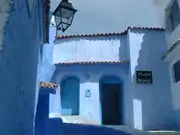
Chefchaouen – or Chaouen, as it is often called by Moroccans – is a popular tourist destination because of its proximity to Tangier and the Spanish enclave of Ceuta. There are approximately two hundred hotels catering to the summer influx of European tourists. One distinction possessed by Chefchaouen is its blue-rinsed houses and buildings.
Chefchaouen is a popular shopping destination as well, as it offers many native handicrafts that are not available elsewhere in Morocco, such as wool garments and woven blankets. The goat cheese native to the area is also popular with tourists.
The countryside around it has a reputation for being a prolific source of kief. The Chefchaouen region is one of the main producers of cannabis in Morocco. A nearby attraction is the Kef Toghobeit Cave, one of the deepest caves in Africa.[8]
Chefchaouen's blue walls are a popular subject of interest. There are several theories as to why the walls were painted blue. One popular theory is that the blue keeps mosquitos away. The blue is said to symbolize the sky and heaven, and serve as a reminder to lead a spiritual life.[9] However, according to some locals, the walls were mandated to be painted blue simply to attract tourists at some point in the 1970s.
The growing tourist industry is geared especially towards Spanish tourists, who are numerous during great Catholic feasts like Semana Santa and Christmas.
Places of worship
The city's oldest and historically most important mosque is the Great Mosque located at Place Uta Hammam at the heart of the medina.[10] On a hill overlooking the town to the east there is also a disaffected mosque built by the Spanish in the 1920s, now a popular lookout point.[11]
Also of great historical and religious importance to the city is the mausoleum dedicated to the patron saint of northern Morocco's Jebalah region, Moulay Abdessalam Ben Mshish al-Alami. His tomb and the village surrounding it is roughly 50 kilometers northwest of from Chefchaouen on the old road to Larache.[10]
Tourism
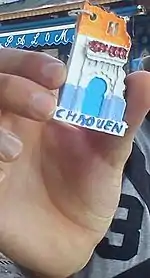
The beauty of Chefchaouen's mountainous surroundings are enhanced by the contrast of the brightly painted medina (old town). The main square in the medina is lined with cafes and filled to the brim with locals and tourist mingling easily. Tourism in Chaouen is also driven by its reputation as center of the marijuana plantations region in north Morocco. During the summer approximately 200 hotels cater to the influx of European tourists.[12]
Sister cities
 Issaquah, Washington, United States[14] (since April 11, 2007)
Issaquah, Washington, United States[14] (since April 11, 2007) Vejer de la Frontera, Spain[15]
Vejer de la Frontera, Spain[15] Ronda, Spain[16]
Ronda, Spain[16] Kunming, China
Kunming, China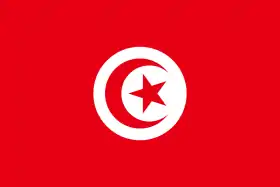 Testour, Tunisia
Testour, Tunisia Mértola, Portugal[17]
Mértola, Portugal[17]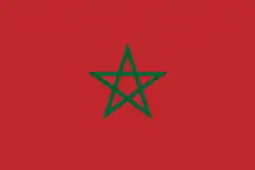 Beni Mellal, Morocco
Beni Mellal, Morocco
Notable people
- Ahmed Hammoudan, professional footballer
- Abdelkarim Tabbal, poet
Gallery
_(4).jpg.webp)
.jpg.webp)
 Blue alley
Blue alley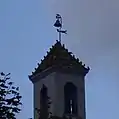 The Iglesia (Spanish for "church"), currently a theatre
The Iglesia (Spanish for "church"), currently a theatre Shrine in Chefchaouen
Shrine in Chefchaouen The beauty of simplicity of the doors
The beauty of simplicity of the doors Woman of Chefchaouen
Woman of Chefchaouen
References and notes
- https://books.google.com/books?id=jdlKbZ46YYkC&pg=PA208#v=onepage&q=morocco&f=false%7C A history of the Maghreb in the Islamic period
- Fiche technique de la Grande Mosquée de Chefchaouen Archived September 28, 2007, at the Wayback Machine (in French), شفشاون Archived 2007-02-08 at the Wayback Machine (in Arabic)
- España y Marruecos, ejemplos de Interculturalidad a través de la lengua - by Francisco Moscoso García
- González Vázquez, Araceli (2011). "Las ciudades santas y prohibidas de Marruecos: La santidad, la sacralidad y la impenetrabilidad de Chefchauen en los textos coloniales españoles y franceses". In Gómez Pellón, Eloy; González Vázquez, Araceli (eds.). Religión y patrimonio cultural en Marruecos. Una aproximación antropológica e histórica. Seville: Signatura Ediciones. pp. 279–280. ISBN 978-84-96210-98-1.
- García, Pablo (29 June 2012). "El Rif en dos colores". El País.
- Yabiladi.com. "History : When an American squadron violated US neutrality laws, bombing Chefchaouen". en.yabiladi.com. Retrieved 2019-07-14.
- Roberts, Charley, 1948- author. (2017-09-08). Charles Sweeny, the man who inspired Hemingway. ISBN 978-1476669946. OCLC 1011663811.CS1 maint: multiple names: authors list (link)
- McWhirter, ed.: Norris (1977). Guinness book of records (24th ed.). Enfield, Middlesex: Guinness Superlatioes Ltd. p. 62. ISBN 090042480X.CS1 maint: extra text: authors list (link)
- "Chefchaouen: Walking the blue streets of Morocco". Middle East Eye. Retrieved 2016-04-10.
- Touri, Abdelaziz; Benaboud, Mhammad; Boujibar El-Khatib, Naïma; Lakhdar, Kamal; Mezzine, Mohamed (2010). Le Maroc andalou : à la découverte d'un art de vivre (2 ed.). Ministère des Affaires Culturelles du Royaume du Maroc & Museum With No Frontiers. ISBN 978-3902782311.
- "Spanish Mosque | Chefchaouen, Morocco Attractions". Lonely Planet. Retrieved 2020-04-12.
- "The Blue City: Chefchaouen - Morocco". I Love Traveling. Retrieved 2016-11-08.
- The equivalent Spanish Wikipedia (42.914 inhabitants at the 1994 census)
The equivalent French Wikipedia found here - A resolution of the city council of Issaquah, Washington, establishing Chefchaouen, Morocco as Issaquah's newest sister city. "Archived copy" (PDF). Archived from the original (PDF) on 2007-06-27. Retrieved 2007-04-11.CS1 maint: archived copy as title (link)
- Chaouen está hermanada con Vejer de la Frontera (Cádiz), que a su vez estuvo bajo el dominio musulmán durante cinco siglos.
- viendo Chaouen desde lejos podríamos pensar que se trata de uno de los pueblos blancos de la Serranía de Ronda. De hecho esta ciudad está hermanada con Ronda. Archived 2007-05-03 at the Wayback Machine
- "Associacao Nacional Municipios Portgugueses". www.anmp.pt. Retrieved 2020-02-16.
External links
| Wikimedia Commons has media related to Chefchaouen. |
| Wikivoyage has a travel guide for Chefchaouen. |
